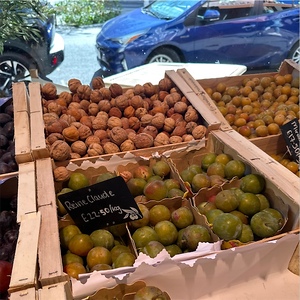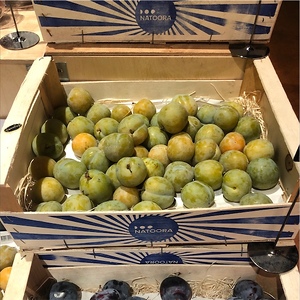


Reine Claude de Bavay Plums
Estimated Inventory, lb : 0
Description/Taste
Reine Claude de Bavay plums are a small to medium-sized varietal, averaging 3 to 5 centimeters in diameter, and have a round to oval appearance with flattened shoulders, tapering slightly to a narrow, curved base. The plum's skin is semi-thin, taut, smooth, and matte, ripening from green to yellow-green, sometimes golden yellow. The skin is also speckled with patches of red blush and is covered in a white powdery bloom, a natural protective layer that is edible but can be easily wiped away. When the fruits are mature, they may exhibit raised, textured scars and cracks. Underneath the surface, the green to golden-yellow flesh is dense, aqueous, and tender with a succulent, slightly firm consistency. Reine Claude de Bavay plums have high sugar content, measuring approximately 30 Brix, and are mixed with acidity, creating a sweet, tangy, and honeyed taste with syrupy floral and fruity nuances.
Seasons/Availability
Reine Claude de Bavay plums are available in the late summer through early fall.
Current Facts
Reine Claude de Bavay plums, botanically classified as Prunus domestica, are a sweet European variety belonging to the Rosaceae family. The fruits are a type of greengage plum and were developed from an open-pollinated cross in Belgium in the mid-19th century. Historically, greengage plums were valued across Europe for their syrupy-sweet, sugary flavor, but original varieties such as Reine Claude Doree plums were challenging to cultivate. Many growers abandoned greengage plums due to their sporadic bearing, sensitive nature, fruit cracking, and slow maturation. When Reine Claude de Bavay plums were developed as an improved variety of the Reine Claude Doree, European growers selected the new cultivar for its favorable characteristics. Reine Claude de Bavay plums are a late-season, self-fertile, and heavy-cropping variety with generally larger and firmer fruits than Reine Claude Doree. The plums grow on trees reaching 2 to 4.5 meters in height, depending on rootstock, and the trees bear fruit within four years, faster than the seven years required for Reine Claude Doree. It is important to note that Reine Claude de Bavay plums must be left on the tree in full sun until they are ripe to develop the sweetest flavor. This ensures that the fruits are also ready to be eaten once they are sold. In modern-day markets, Reine Claude de Bavay plums are the standard commercial greengage plums sold in European stores. Other improved varieties of greengage plums have also been created over time, but Reine Claude de Bavay has remained a choice market plum for its consistency and reliability. Reine Claude de Bavay plums taste sweet and acidic, utilized in fresh and cooked preparations.
Nutritional Value
Reine Claude de Bavay plums are a source of vitamin C to strengthen the immune system while boosting collagen production, potassium to balance fluid levels within the body, and vitamin A to maintain healthy organ functioning. The plums also provide vitamin K to assist in faster wound healing, calcium to build strong bones and teeth, fiber to regulate the digestive tract, and other nutrients, including phosphorus, vitamin E, antioxidants, and B vitamins.
Applications
Reine Claude de Bavay plums have a balanced, sweet, and tangy flavor suited for fresh and cooked preparations. The fruits are traditionally consumed straight out of hand and are savored for their honeyed taste. Reine Claude de Bavay plums are also tossed into salads, chopped into fruit medleys, stirred into yogurt, or sliced and served on cheese boards as a sweet accompaniment. In addition to fresh preparations, Reine Claude de Bavay plums are popularly simmered into jams, compotes, chutney, and sauces as their flesh cooks down quickly. These sweet preserves can be incorporated into baked goods and pastries or used as a sauce for roasted meats such as pork and lamb. Reine Claude de Bavay plums can also be cooked into tarts, cakes, and crumbles, poached in syrup, or frozen and blended into sorbet. The small fruits are sometimes pickled or fermented, and they are also infused into spirits and liqueurs. Reine Claude de Bavay plums pair well with vanilla, spices such as cinnamon, cloves, and nutmeg, fruits including citrus, raspberries, and blueberries, cheeses such as Manchego, brie, ricotta, and mozzarella, and nuts including almonds, pine, or walnuts. Unwashed Reine Claude de Bavay plums will keep up to one week when stored in the refrigerator.
Ethnic/Cultural Info
Reine Claude de Bavay plums, along with other varieties of greengage plums, are celebrated in France, especially when grown in Moissac, a commune in the Tarn-et-Garonne department. Moissac is thought to have been the site of origination for greengage plums, and the sweet fruits thrive in the region's hot, sunny days and cold nights. The plums grow on farms situated in fertile river valleys, sunny slopes, and gently rolling hills. Moissac is famous for its unique microclimate, being at the center of where the Atlantic and Mediterranean climate zones converge. Greengage plums are intentionally left on the tree to ripen, developing the richest, sweetest flavor. There are approximately 4,700 acres of greengage plums cultivated in Moissac, and the region supplies over three-quarters of France's greengage crop. Once the plums are ready for harvest, they are shipped to markets where vendors display the fruits with certificates showing that the plums were grown in Moissac. This certificate is a mark of quality to showcase that the plums should have a sweet, syrupy, and juicy nature and that the fruits were grown in a specialized terroir for the best eating experience.
Geography/History
Reine Claude de Bavay plums are a type of greengage plum that was developed in Malines, Belgium, in 1832. The variety was created from a greengage plum, most likely the Reine Claude Doree, that had been open-pollinated, and the fruits of the natural cross were selected by Major Esperens as a new variety. Reine Claude de Bavay plums were distinct from their parent cultivars as they are later ripening, have a slightly firmer texture, and showcase improved cultivation characteristics. In 1843, Reine Claude de Bavay plums were named in honor of M. de Bavay, the Director of the Royal Nurseries at Vilvoorde, a horticultural station near Brussels. The variety was introduced to growers in England by Thomas Rivers in 1846 as an improved version of the classic but finicky Reine Claude Doree plum, and the fruits appeared in catalogs of the American Pomological Society by 1856. Throughout history, Reine Claude de Bavay plums have remained a small-scale commercial cultivar in Europe. The plums are viewed as a seasonal supermarket plum and are sold as a dual-purpose variety for fresh eating and cooking. Outside of Europe, Reine Claude de Bavay plums are rare and are grown in limited quantities by select farms in the United States, Australia, and New Zealand.
Recipe Ideas
Recipes that include Reine Claude de Bavay Plums. One
| Dula Notes |
|
Sour Cherry + Yellow Plum Galette |
| Nourish and Nestle |
|
Spiced Golden Plum Jam |









